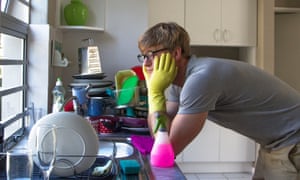Even light activity such as household chores
might help to keep the brain young,
researchers say, adding to a growing body
of evidence that, when it comes to exercise,
every little helps.
The findings mirror upcoming guidance
from the UK chief medical officers, and
existing US guidelines, which say
light activity or very short bouts
of exercise are beneficial to health –
even if it is just a minute or two
at a time – countering the previous
view that there was a threshold that
must be reached before there
were significant benefits.
“Our study results don’t discount
moderate or vigorous physical
activity as being important for
healthy ageing.
We are just adding to the science,
suggesting that light-intensity
physical activity might be important too,
especially for the brain,” said Dr Nicole Spartarno,
first author of the study from Boston University,
adding that light activity might include a
gentle walk or household chores.
From the latter, the researchers worked out
individuals’ brain volume, a measure linked to
ageing: about 0.2% of the volume of the brain
is lost every year after the age of 60. Loss or
shrinkage of brain tissue is linked to dementia,
Spartano noted.
After taking into account factors including sex,
smoking status and age, the team
found that every extra hour of light
physical activity per day was linked to
0.22% greater brain volume, equal to
just over a year’s less brain ageing.
What’s more, those who took at least
10,000 steps a day had a 0.35%
greater brain volume than those
who took, on average, fewer than
5,000 steps a day – equivalent to
1.75 years’ less brain ageing.
the team looked at those who did
not meet recommended guidelines
for physical activity –
just over half of the participants.
While the results also suggested
that greater levels of moderate
to vigorous physical activity were
linked to higher brain volumes,
the team say further analysis
suggests this could just be because
these people were also doing more light activity.
But Spartano said, even if true, that
did not mean people should stop
trying to break a sweat.
“Higher levels of fitness
are linked to longevity and a better
quality of life in older age, not to
mention being associated with
lower rates of dementia,” she said.
However the study has limitations:
it is based on a snapshot in time,
used mainly white participants, and
cannot prove cause and effect –
those with more brain ageing
might move less. The authors
add that not all time spent sedentary
is necessarily “bad” for the brain –
particularly if people are engaged
in a task that takes a lot of thinking.
Emmanuel Stamatakis, professor
of physical activity, lifestyle and
population health at the University
of Sydney, welcomed the overall
message, but questioned some of
the results.
“The finding that even light-intensity
physical activity, that it is usually
part of daily living, is associated with
brain volume is very encouraging as
such activities are feasible for most
middle-aged and older people, even
those who are less likely to do structured
exercise,” he said.
But, he added, there was no biologically
plausible reason moderate to vigorous
activity would have less effect on brain
volume than light activity.
For cardiovascular health, said
Stamatakis, a minute of high-intensity
activity was known to be more
beneficial than a minute of light activity.
Dr James Pickett, head of research
at Alzheimer’s Society, stressed that
the research did not look at the
impact of different levels of activity
on dementia risk, although it is known
that, in general, exercise reduces
the risk of such conditions. “Don’t worry
if you’re not hill-running, but find something
you enjoy and do it regularly, because
we know that what’s good
for the heart is good for the head,” he said.
